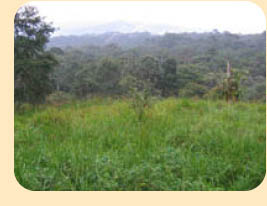 Project Description and Current Status:
Project Description and Current Status: South America is the world's richest continent for bird species (3,200), of which approximately 658 are range restricted (species with breeding ranges less than 50,000 sq. km). The center of this diversity is the Andes, which harbors the greatest concentration of restricted-range species in South America, has one of the highest concentrations of the world's threatened bird species, and as such ranks first among the world's 25 “hotspots” in terms of diversity and endemism of both plant and vertebrate species. Like other major biodiversity hotspots, the tropical Andes region has already suffered extensive loss of habitat.
Cajas National Park covers more than 28,000 hectares in the high Andes of southern Ecuador and is situated on the continental divide approximately 35 km west of Cuenca. Elevation in the park ranges from 3160 to 4450 meters and about 90% of the park is paramo interspresed with small patches of Polylepis forest.
The original vegetation of the remaining area was high Andean cloud forest, but much of this area (though now protected) has been affected for several decades by human disturbances including forestry and grazing. The park serves as a major water catchment for the city of Cuenca and other surrounding villages; approximately 80% of the city's water comes from rivers and streams originating in the park. The park is designated as a wetland of international importance (RAMSAR) and an internationally important bird area (IBA). It is home to at least 144 species, 6 of which are migratory and 9 of which are threatened.
We are quantifying how avian community structure, demographics (age and sex), and fitness correlates (i.e. parasite loads, fat, muscle mass, plumage condition, and site fidelity) varies by habitat type. Given that there is extensive deforestation in the region, and that habitat change is a continuing threat to birds, it is imperative to evaluate how community structure will change with continued deforestation or reforestation.
By conducting a mark/recapture study we will be able to assess abundance patterns, general health and fitness correlates of birds, and site fidelity in different habitat types. Ultimately, this work will also provide estimates of survival and reproductive success, and will inform species level studies focused on species of conservation concern, or more detailed studies of habitat selection and behavior.
Community level studies are being completed through mist netting and point counts. We are focusing on three habitat types: 1) Polylepis forest (bosque de quinua), 2) High elevation cloud forest (bosque altoandino primario) which varies in disturbance levels resulting from extraction of large timber trees from accessible areas, and 3) secondary high elevation cloud forest (bosque altoandino secundario) which varies from open pasture type habitat to a more dense forest of 2-7 meter stature. We are conducting two days of netting per site, four times a year for the next five years. Point counts are being conducted monthly as a complementary means of determining relative abundance and community structure. Point counts also allow us to confirm habitat relationships of understory birds determined through mist netting, and allow us to also quantify habitat relationships of those species that primarily frequent the canopy and so are not well cesused with mist nets.
The research outlined here will be followed by more intensive study of a limited number of bird species where we will focus on factors such as movement behavior, habitat use, survival, and nesting success (where possible). We will use spot mapping, radio telemetry, nest-searching, DNA sequencing, and other appropriate methods in these efforts. Again, this work will be done in a landscape context.
Recent Results: Preliminary results are not available at this early stage of the project.
Funding: This project has been supported by Parque Nacional Cajas, National Science Foundation, EcoCiencia, SUNY-Stony Brook, and PRBO Conservation Science.
Related Scientific Publications:
Latta, S. C., C. C. Rimmer, and K. P. McFarland. 2003. Winter bird communities in four habitats along an elevational gradient on Hispaniola. Condor 105:179-197.


